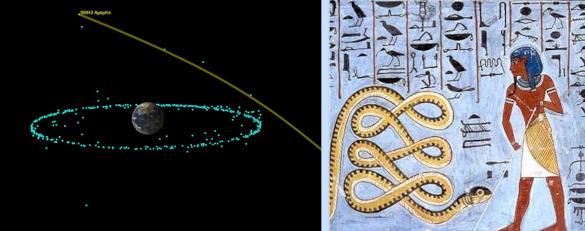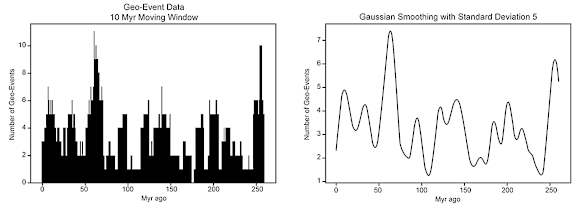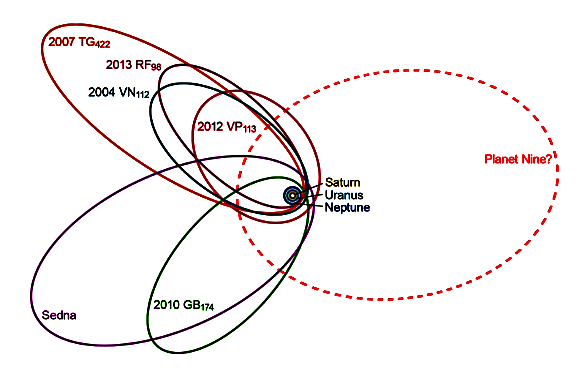Earth's Pulse
September 6, 2021
Our
Solar System is much more serene than it was 4.5 billion years ago. At that time, the
Mars-sized
planet,
Theia,
collided with an early Earth to create our present
Earth and
Moon. This was actually a fortunate occurrence, since much of our
water appears to have come from Theia. Still, Earth has experienced a few
extinction events caused by
meteor impacts in the past several million years, the most famous of which is the
extinction of the dinosaurs about 66 million years ago. This was caused by the impact of a 10
kilometer asteroid at the Gulf of Mexico, I wrote about this event in a
previous article (The Tanis Deposit, May 6, 2019).
Now that
humans have the capability to protect themselves against such
catastrophes (see my
June 12, 2012, article on the Yarkovsky Effect), we would be remiss not to monitor the skies for threatening
asteroids.
NASA has created the
Center for Near-Earth Object Studies for
computation of the
orbits of
Near-Earth Objects (NEOs) and assessing their impact
probabilities in the future.[1] Previously high on the list of possible impactors, but recently downgraded, is the asteroid
99942 Apophis.[1]

The projected 2029 trajectory of the asteroid, 99942 Apophis, which shares its name with the Egyptian deity, Apep, also known by his Greek name, Apophis (Ἄ&pi'οφις). Apep was the greatest enemy of Ra, the Egyptian Sun god, and he was depicted as a giant snake, a probable consequence of his being formed from Ra's umbilical cord. (Left, a still image from a NASA/JPL-Caltech YouTube video showing the calculated orbital trajectory of asteroid 99942 Apophis as it will encounter the Earth on April 13, 2029. The blue dots are geosynchronous satellites, which indicate the nearness of the encounter. Right, a portion of a Wikimedia Commons image depicting Apep held at bay by a deity in the tomb of Pharaoh, Ramses I, circa 1307 BC. Click for larger image.)
After its 2004 discovery, there was a small probability that 99942 Apophis would impact the Earth in 2068. This would be a major problem, since the asteroid is estimated to be about 350
meters in
diameter. Recent
observations have ruled out any impact risk in 2068 and for many subsequent encounters, but it still approaches Earth closely. On April 13, 2029, Apophis will pass Earth at a distance closer than the distance of
geosynchronous satellites (see figure, above).[2]
Impact of large meteors leave a definite imprint in the
geological record, but there are other major geological events that lack such a simple explanation. A team of
geologists from
New York University (New York, New York) and the
Carnegie Institution for Science (Stanford, California) have recently
published an
open access paper in
Geoscience Frontiers in which they present evidence that major geological events are
cyclic, happening in a 27.5 million year cycle.[3-6] This cycle may be the result of the motion of the Earth in the Solar System and our
Milky Way Galaxy.[3]
Says geologist,
Michael R. Rampino, team leader for the study and a
professor in
New York University's Department of Biology, "Many geologists believe that geological events are
random over time. But our study provides statistical evidence for a common cycle, suggesting that these geologic events are
correlated and not random."[4] The research team examined 89 well-dated major geological events of the last 260 million years. These events include[3-4]
• Marine and land extinctions
• Major volcanic outpourings of lava called continental flood-basalt eruptions
• Major ocean anoxic events (events when oceans were depleted of oxygen)
• Sea levell fluctuations
• Global pulses of intraplate magmatism
• Changes in seafloor spreading rates and tectonic plate reorganizations
The most recent cluster of disastrous geological episodes occurred about 7-10 million years ago; so, the expectation is that we're at least 15 million years away from a series of catastrophic events that might cause
human extinction.[6] However, in 15 million years, humans (at least those who inhabit the Earth and not another planet) might be
technologically equipped to prevent such a tragedy. A
Fourier analysis of the data for these 89 events gives a
spectral peak at 27.5 million years at a
confidence level greater than 95%. There's also evidence for a significant shorter period of about 9-10 million years.[3]

Left, the results of moving window analysis of the 89 geologic events using a 10-Myr moving window centered every 0.5 Myr. The number of occurrences that fell within the moving window were computed at 1-Myr intervals. Right, Gaussian smoothing of these data with a standard deviation of 5 Myr centered at every 0.1 Myr. (Fig. 1 of ref. 3, licensed under the Creative Commons Attribution-NonCommercial-NoDerivatives 4.0 International License.[3] Click for larger image.)
This study was enabled by recent improvements in
radioisotope dating techniques.[4] Says Rampino, "Back in the early
20th century, no one had very good evidence to show whether they were cycles or not... and many or most geologists thought that these cycles were random."[6] This prevented a
quantitative analysis until now.[6] One problem with the analysis is an unavoidable double counting. Since many events are
causal, some of the 89 events are related.[5] For example, anoxic events cause marine extinction.[5] A prior study in 2018 found a 26 million year cycle in examination of the Earth's
carbon cycle and plate tectonics.[5]
So, what is the likely cause for this periodicity? Two potential candidates are processes relating to plate tectonics and astronomical cycles of the Earth's motion in the Solar System and our Milky Way Galaxy.[3] Also possible are
comet strikes and the orbit of the elusive
Planet Nine.[5] I wrote about Planet Nine in an
earlier article (Planet Nine, June 27, 2016).

The orbit of Planet Nine and other Trans-Neptunian objects. Note, especially, the small size of the orbit of Neptune in this illustration. (Wikimedia Commons image by nagualdesign.)
References:
- Sentry: Earth Impact Monitoring - Impact Risk Data, Center for NEO Studies (CNEOS).
- Ian J. O'Neill and Joshua Handal, "NASA Analysis: Earth Is Safe From Asteroid Apophis for 100-Plus Years," NASA Press Release 2021-062, March 26, 2021.
- Michael R. Rampino, Ken Caldeira, and Yuhong Zhu, "A pulse of the Earth: A 27.5-Myr underlying cycle in coordinated geological events over the last 260 Myr," Geoscience Frontiers, vol. 12, no. 6 (June 17, 2021), Article No. 101245, https://doi.org/10.1016/j.gsf.2021.10124. This is an open access article with a PDF files at the same address.
- The Earth Has a Pulse—A 27.5-Million-Year Cycle of Geological Activity, New York University Press Release, June 18, 2021.
- Jacinta Bowler, "Earth Has a 27.5-Million-Year 'Heartbeat', But We Don't Know What Causes It," Science Alert, June 21, 2021.
- Thaïs Grandisoli, "Earth has a 27.5-million-year 'pulse' of major geological events, says study," CBC News, July 1, 2021.
Linked Keywords: Solar System; Mars; planet; Theia; giant-impact hypothesis; collision with an early Earth; Earth; Moon; water; extinction event; impact event; meteor impact; Cretaceous-Paleogene extinction event; extinction of the dinosaurs; kilometer; asteroid; Chicxulub crater; Gulf of Mexico; human; disaster; catastrophe; Yarkovsky Effect; asteroid; NASA; Center for Near-Earth Object Studies; computation; orbit; Near-Earth Objects (NEOs); probability; 99942 Apophis; extrapolation; projection; trajectory; ancient Egyptian deity; Apep; Greek language; enemy; Ra; Egyptian Sun god; snake; umbilical cord; JPL-Caltech; YouTube video; geosynchronous satellite; Wikimedia Commons; tomb; Pharaoh; Ramses I; Anno Domini; BC; meter; diameter; observational astronomy; observation; geologic record; geological record; geologist; New York University (New York, New York); Carnegie Institution for Science (Stanford, California); scientific literature; publish; open access journal; open access paper; Geoscience Frontiers; cyclic; Milky Way Galaxy; Michael R. Rampino; professor; New York University's Department of Biology; randomness; random; correlated; marine (ocean); volcano; volcanic; lava; continental flood-basalt eruption; ocean anoxic event; oxygen; sea level; pulse (physics); tectonic plate; magma; magmatism; seafloor spreading; tectonic plate; human extinction; technology; technological; Fourier analysis; spectrum; spectral; confidence interval; confidence level; window function; moving window analysis; geology; geologic; Gaussian smoothing; data; standard deviation; Creative Commons Attribution-NonCommercial-NoDerivatives 4.0 International License; radiometric dating; radioisotope dating; 20th century; quantification (science); quantitative; causality; causal; carbon cycle; comet; Planet Nine; trans-Neptunian object; orbit; Neptune.